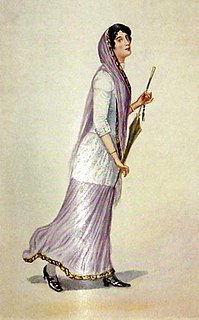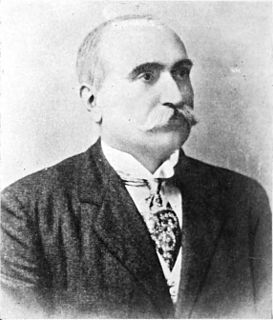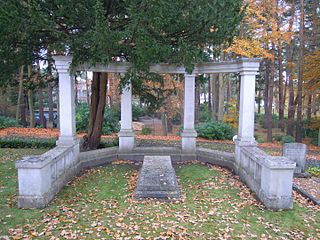
Parsis or Parsees are an ethnoreligious group of the Indian subcontinent whose religion is Zoroastrianism. Their ancestors migrated to the region from Sassanid Iran following its conquest by Arab Muslims under the Rashidun Caliphate in the 7th century CE. They are the first of two such groups to have done so, with the other being Iranis, who migrated to the subcontinent many centuries later following the rise to power of the Qajar dynasty in 18th-century Iran. According to a Zoroastrian epic, Qissa-i Sanjan, Parsis continued to migrate from Iran to Gujarat in between the 8th and 10th centuries CE, where they were given refuge to escape religious persecution by Muslims during and after the early Muslim conquests.

A dakhma, also known as a Tower of Silence, is a circular, raised structure built by Zoroastrians for excarnation, in order to avert contamination of the soil and other natural elements by the dead bodies. Carrion birds, usually vultures and other scavengers, consume the flesh. Skeletal remains are gathered into a central pit where further weathering and continued breakdown occurs.
Mazagaon, also spelled Mazgaon and Mazagon, and pronounced by the Catholics as 'Mazgon' or 'Maz-a-gon' and the Marathi-speakers as Mazgav, is one of the seven islands of Mumbai. It is part of South Mumbai and can be reached by Byculla Station on the Central railway line and Dockyard Road Station on the Harbour Railway line. Located in Mazagaon are maritime companies like the Bombay Port Trust and Mazagaon Dock Ltd., the Mazagaon Court and Anglo-Indian schools including Rosary High School, St. Peters School, Antonio D'Souza High School, Diamond Jubilee High School and St. Mary's School.

Bhikaiji Rustom Cama or simply as, Madam Cama, was one of the prominent figures in the Indian independence movement.
The Bombay Quadrangular was an influential cricket tournament held in Bombay, India played between 1892–93 and 1945–46.
Ratanji Dadabhoy Tata was an Indian businessman who played a pivotal role in the growth of the Tata Group in India. He was the first cousin of Jamsetji Tata, a pioneering industrialist of India and the Founder of Tata Sons. He was one of the partners in Tata Sons founded by Jamsetji Tata. Ratanji is the father of J. R. D. Tata.
The Sheriff of Mumbai is an apolitical titular position of authority bestowed for one year on a prominent citizen of Mumbai.

Sir Dorabji Tata was an Indian businessman of the British Raj, and a key figure in the history and development of the Tata Group. He was knighted in 1910 for his contributions to industry in British India.

The Story of Sanjan is an account of the early years of Zoroastrian settlers on the Indian subcontinent that was originally written in 1599 CE by Parsi priest, Bahman Kaikobad. In the absence of alternatives, the text is generally accepted to be the only narrative of the events described therein, and many members of the Parsi community perceive the epic poem to be an accurate account of their ancestors.

The persecution of Zoroastrians has been recorded throughout the history of Zoroastrianism, an Iranian religion. The notably large-scale persecution of Zoroastrians began after the rise of Islam in the 7th century CE; both during and after the conquest of Persia by Arab Muslims, discrimination and harassment against Zoroastrians took place in the form of forced conversions and sparse violence. Muslims who arrived in the region after its annexation by the Rashidun Caliphate are recorded to have destroyed Zoroastrian temples, and Zoroastrians living in areas that had fallen under Muslim control were required to pay a tax known as jizya.

Sir Nowroji Saklatwala, was an Indian businessman who was the third chairman of the Tata Group from 1932 till his sudden death in 1938.

Bombay, also called Bom Baim in Indo-Portuguese creole, is the financial and commercial capital of India and one of the most populous cities in the world. It's also the cosmopolitan city centre of the Greater Bombay Metropolitan Area, and the cultural base of the Bollywood film industry. At the time of arrival of the Portuguese Armadas, Bombay city was an archipelago of seven islands. Between the third century BCE and 1348, the islands came under the control of successive Hindu dynasties. The Delhi Sultanate had been ruling the area along with Chaul, New Bombay (Thana)& Damaon, with the administrative centre in Bassein (Vasai) since the raids of Malik Kafur in the Konkan region and across the Indian subcontinent. This territory in North Konkan along with the Bombay islands were later taken over by the Sultan of Guzerat from 1391 to 1534, when he had declared the end of suzerainty to Delhi after the Timurid invasion of it. Growing apprehensive of the power of the Moghul emperor Humayun, Sultan Bahadur Shah of Gujarat was obliged to sign the Treaty of Bassein on 23 December 1534, according to which, the seven islands of Bombay, Fort San Sebastian of Bassein in strategic town of Bassein (Vasai), and its dependencies were offered to the Portuguese East Indies, the territories were only later officially surrendered on 25 October 1535, by the Sultan of Guzerat.
Dosabhai Framji Karaka was an Indian newspaper editor and official, known for his history of the Parsis.

Manockjee Cursetjee (1808–1887) was an Indian businessman and judge from Bombay, remembered as a Parsi reformer and proponent of female education.
The Bombay Dog Riots, also known as the 1832 Bombay Riots, were a series of protest actions that devolved into rioting in the city of Mumbai, India. The riots were sparked by an attempt by the British government to exterminate the city's stray dogs, controversial for Parsis due to dogs being considered sacred in the Zoroastrian religion. The event was the first instance of rioting in the modern history of Mumbai.

Sharifabad, Ardakan is a township in the Central District of Ardakan County, Yazd Province, Iran. It is located near the county capital, Ardakan, and had a population of 4,000 as of the 2006 census. Sharifabad is one of the Zoroastrian centres of Iran, home to numerous Zoroastrian holy sites. Every summer, thousands of Zoroastrians from around the world gather here on pilgrimage. Sharifabad is also notable for the 1,000-year-old Qutbabad aqueduct that runs through the village. The village is home to both Muslims and Zoroastrians who worship separately and respect each other's beliefs.
The Bombay Parsi Punchayet is the apex body representing the Parsi Zoroastrian Community in Mumbai. BPP was founded in the 1670s. It is a charitable trust and is the city's largest private landlord controlling over 5500 houses meant for lower and middle class members of the Parsi community. It is also the Mumbai's oldest and richest charity.

Mathabana was an essential part of ladies' costumes in Parsi culture in Zoroastrianism. Mathabana is a loose garment similar to the veil, particularly for preventing the display of hairs. It was a piece of thin white linen to tie around the head. Parsi women were supposed to cover their hair to appear simple and limit their feminine beauty out of modesty and respect for their culture. The idea has initially been brought from Persia and continued until 50 years back. Males wore skull caps, and females were supposed to wear Mathabana; an uncovered head was considered sinful and against the religion.








